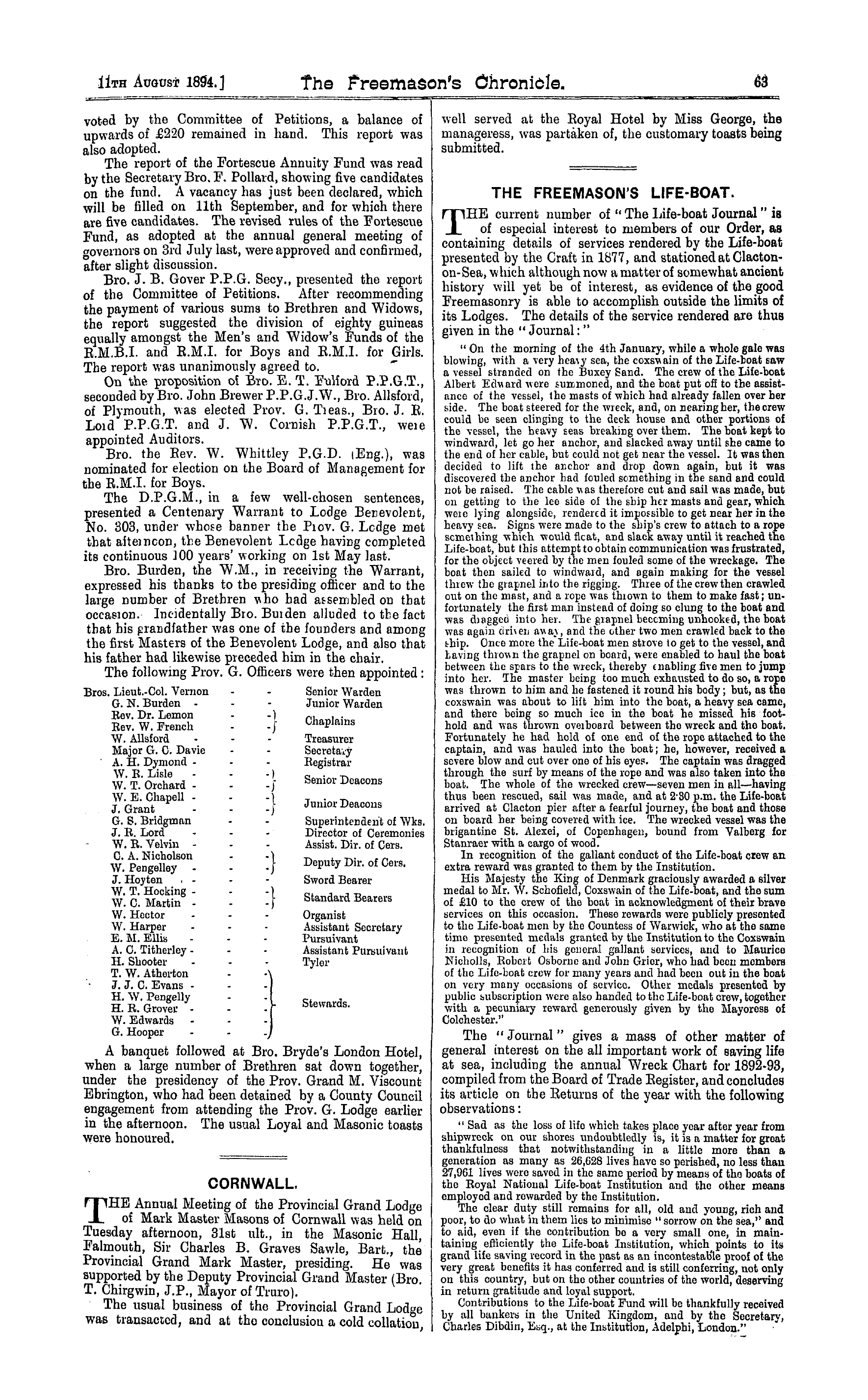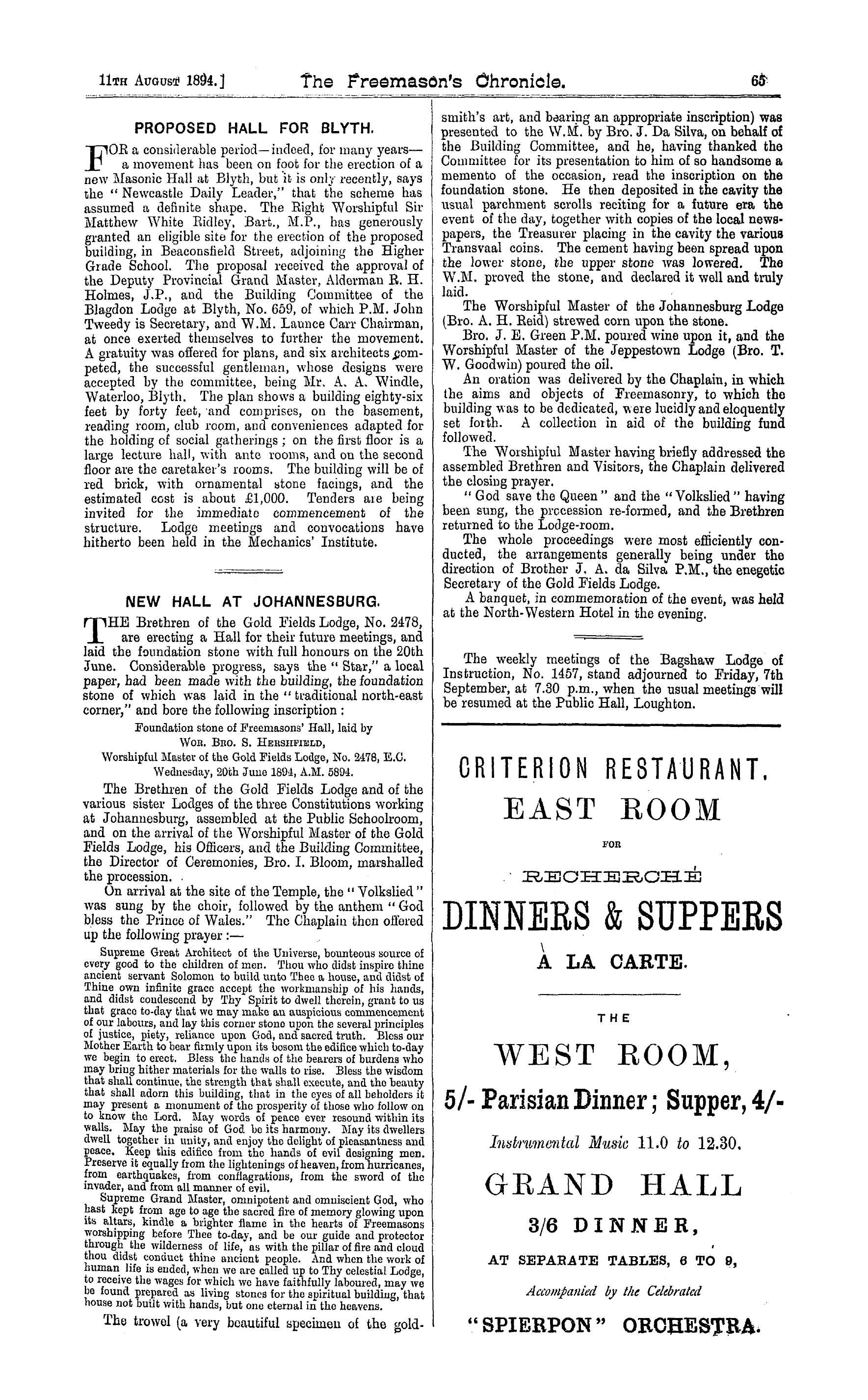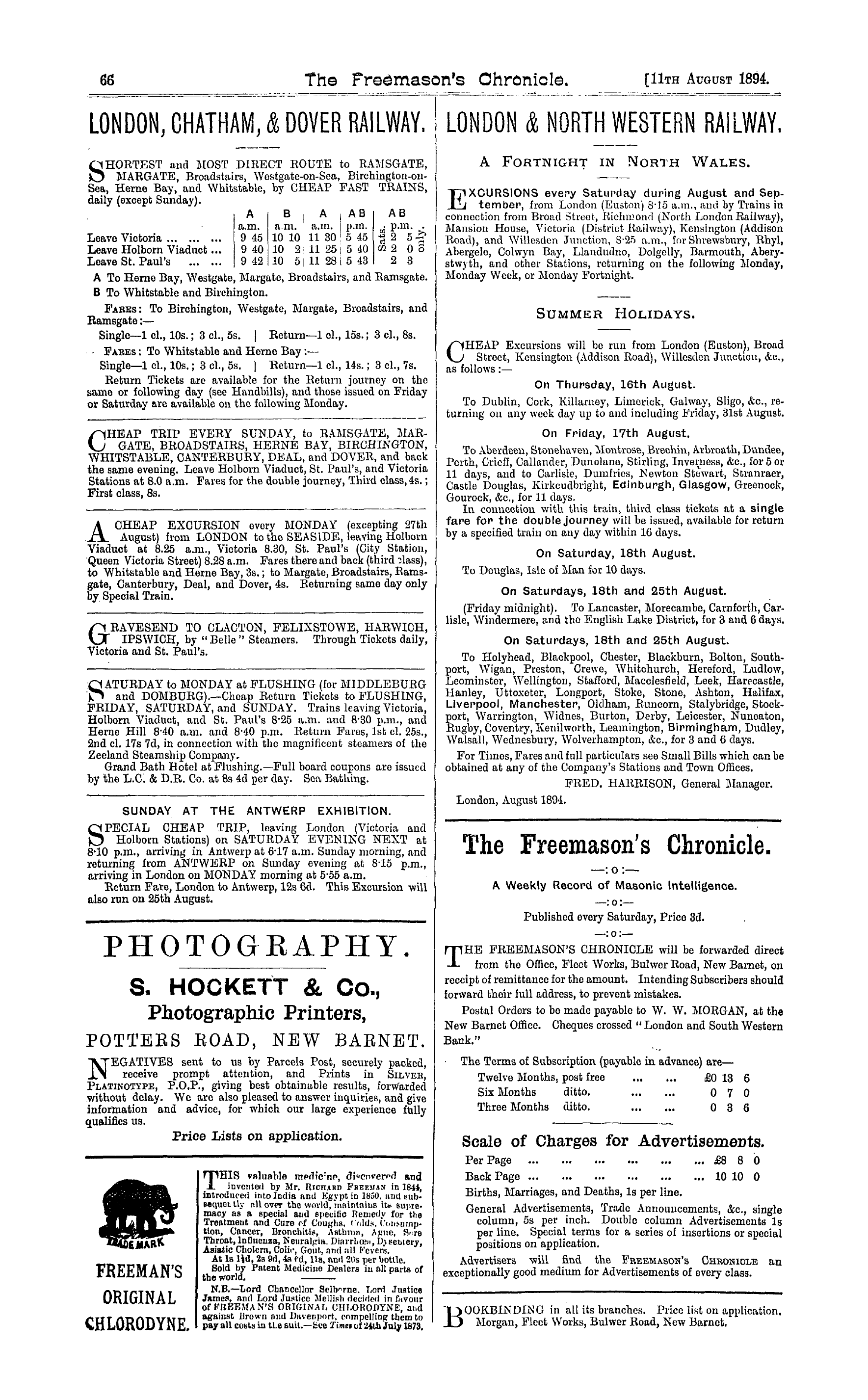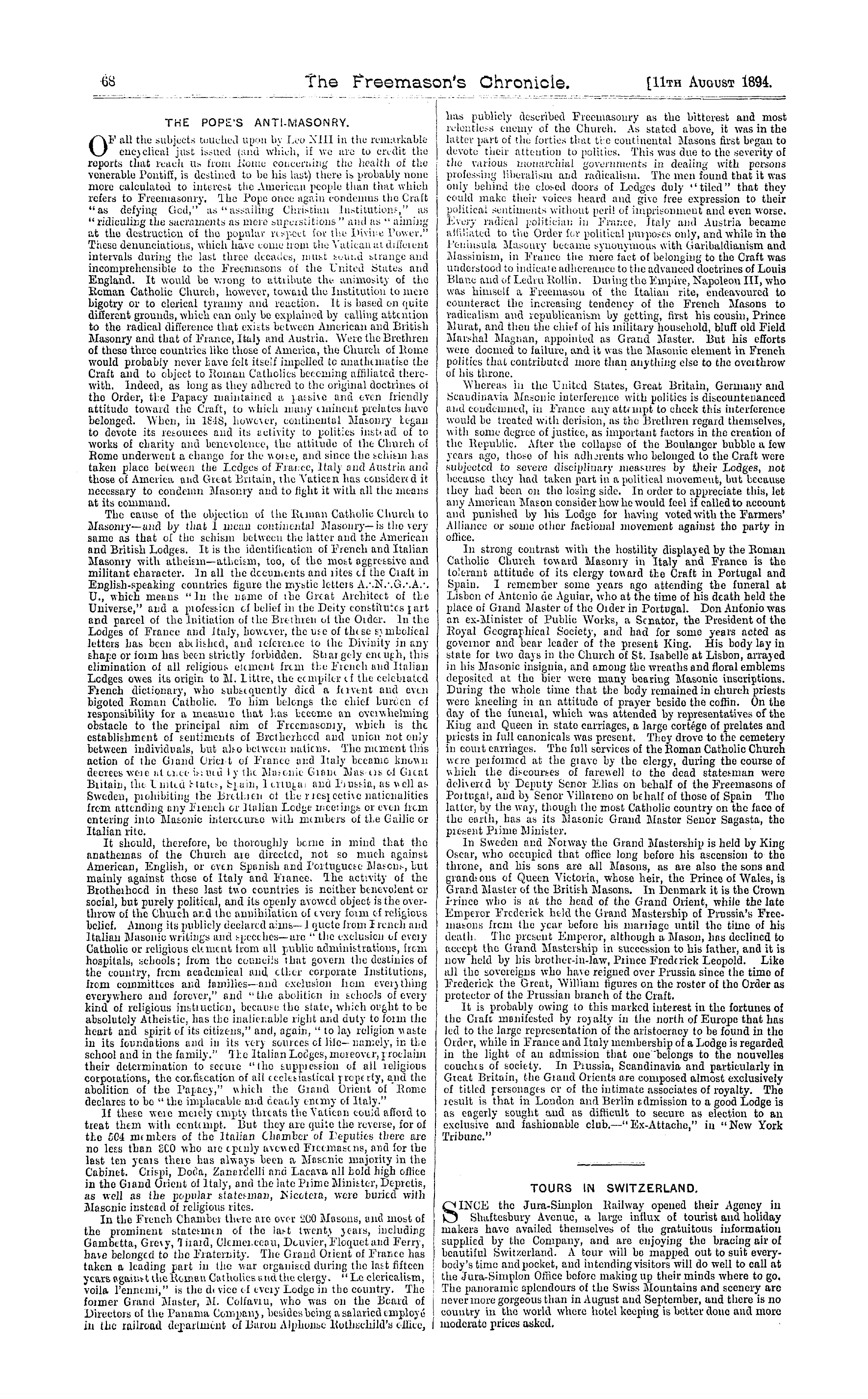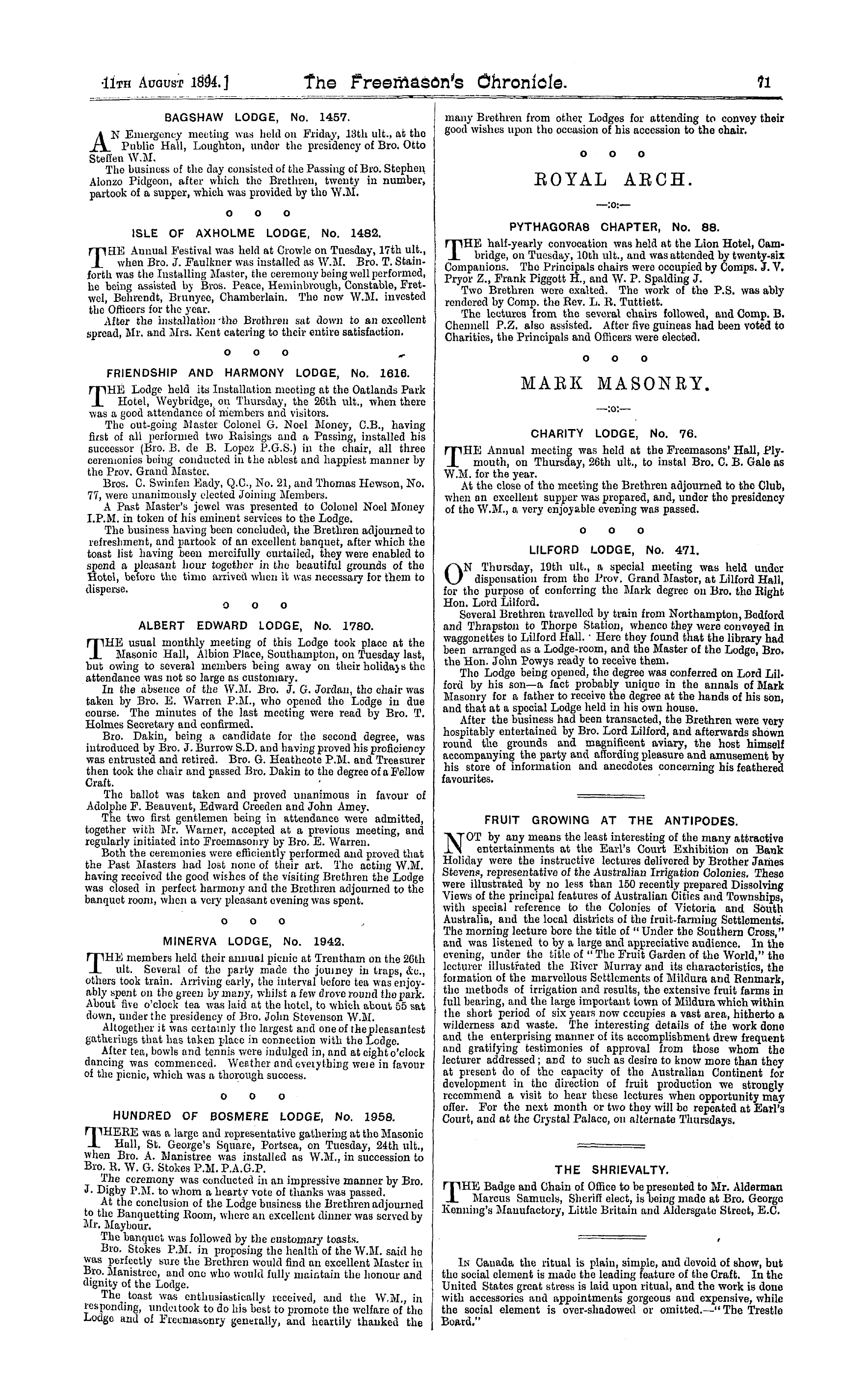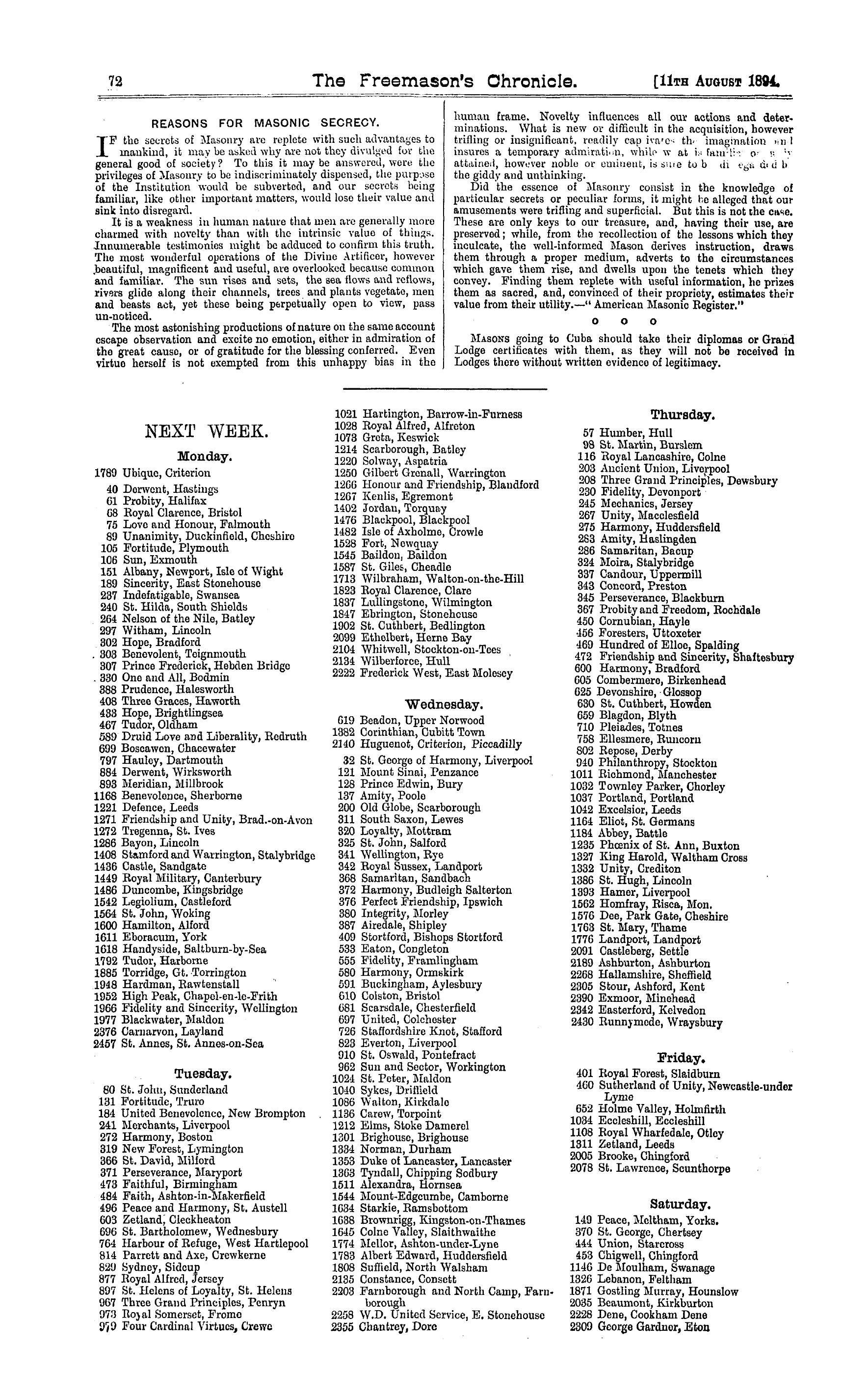-
Articles/Ads
Article CHURCH SERVICES. Page 1 of 2 Article CHURCH SERVICES. Page 1 of 2 →
Note: This text has been automatically extracted via Optical Character Recognition (OCR) software.
Church Services.
CHURCH SERVICES .
AS E R VI C E unique in the annals of local Freemasonry was held last month in St . John ' s Church , Stratford , on behalf of the West Ham Hospital . The nave of the church was reserved for the Brethren ,
the public , who were admitted by ticket , being seated in the aisles , which were well filled . A marquee had been erected in the church grounds to enable the Brethren
attending the service to invest themselves with then-Masonic clothing and the insignia of office . From here a procession was formed into the church , the processional hymn being the " Old Hundredth . "
The Bible was placed on the pedestal of the West Ham Abbey Lodge , in front of the chancel steps . A shortened form of evening service was conducted by Bro . the Rev . Canon Stevens , Bro . the Rev . J . Percy Noyes reading the special lessons .
The musical portions of the service were exceedingly well rendered by the choir of the church , under the Organist ( Mr . Taylor ) . Bro . the Rev . W . Quennell preached the sermon ,
from texts taken from the books of Deuteronomy and Leviticus . After the blessing , " Now the evening shadows closing " was sung , and the procession was reformed and returned to the tent .
The Rev . Canon Stevens addressed a few words to the
Brethren , says the " East London Observer , saying that though that was the first service they had held , he trusted it would not be the last ; and he wished them every success in their Order .
The Canon ' s words were well received . The collection amounted to £ 26 , which will be handed intact to the West Ham Hospital , as the Brethren of the West Ham Abbey Lodge , the charitable exertions of whose members
is referred to elsewhere in this issue , have arranged to bear the expenses . The whole of the arrangements for the service were admirably made and carried out by Bro . F . C . D . Fenn ( the Secretary of the West Ham Lodge ) , and reflected great credit upon him .
o o o THE following address was delivered at a service for Freemasons , held at the Bromley Parish Church on 24 th June , with the concurrence and assistance of the Rev . Jno . Parry , M . A ., who is Chaplain of the Bromley
St . Leonard Lodge . The musical arrangements were under the direction of Bros , the Rev . J . H . Lewthwaite ( choirmaster ) , J . W . Gibbs , and W . F . Keddall . The Brethren mustered in the schoolroom adjoining the
church , to the number of nearly three hundred , and there attired themselves in their regalia , and joined in procession , after the clergy and choir , into the church . There were representatives of all degrees in Freemasonry .
In the prayers read by the Archdeacon special reference was made to the sick , for whom , at the Victoria Park Hospital , assistance was sought . The Rev . John Parry , the Vicar , read the lesson of the day , and the anthem ,
" The Heavens are telling , " was rendered by the choir . Archdeacon Sinclair ' s address was listened to throughout with the closest attention , both by Masons and non-Masons ; his historical references being followed by all with the deepest interest :
FREEMASONRY AS KNOWN TO THE WORLD . I Kings vii , 13-21 . FREEMASONRY is a principle which has existed in all stages of civilisation . The state in which we know it , of a vast Brotherhood of amateur Masons , who are not really builders , but who , as everybody knows , have adopted the signs and symbols of the Building Craft to express their own secret nrincinle . is as far as
we know about two-and-a-half centuries old . The first instance of a gentleman or amateur being accepted into one of the Lodges of the old Building Crafts is that of Elias Ashmole , the antiejuary ( afterwards Windsor Herald to King Charles 2 nd ) , who along with Colonel Mainwaring was entered at Warrington in 1646 . It is believed that there are now more than 10000 Lodgesand more
, , than 1 , 000 , 000 members . The conception of Freemasonry implies , like the Christian Church , cosmopolitan or universal Brotherhood , and was impossible to the ancient world , or until the Brotherhood of man was taught by Jesus of Nazareth . But the principle of sacred moral and religious societies on the one hand , and the
principle of Brotherhoods of the Building Craft on the other , are as old as civilisation itself ; and it is of these two tbat speculative Freemasonry is the modern representative . The principle of moral and relrgrous societies is represented in ancient times by the Pythagoreans and the Eleusinians among the Greeks , by the Essenes
Church Services.
amongst the Jews , and by tho Carmathites and Fedavi , who wero tho mystic Ratiorralists of the Mahomedans . But the truo historical precursors of our modern Brotherhood of Freemasons were the mediceval building corporations , who may themselves have a remote connection with the East ; while amongst the Romans there were collegia , or skilled Fraternities for the same
purpose . These Roman collegia had au exchequer , an archive , patrons , religious ceremonies , an oath , a benefit and burial fund , and a register . Their officers were masters , wardens , recorders ancl censors , and they instructed their apprentices to a certain extent in secret . There can bo no doubt that such fellowships existed for centuries in Gaul and Britain , and it is probable that
they deposited in these countries the tradition of their ideas and habits . And again , at a later period , there was a distinct invitation sent from the West to the building corporations of Byzantium ; the reforms of the Emperor Leo , who was zealous in breaking down Christian idolatory , inclined thc Masons to avail themselves of the opportunity . The European building societies themselves ,
however much they owed to the traditions of the Roman skilled Fraternities , and of these building societies from the East , were independent and original growths ; of these the most distinctive type is found in the Steinmetzen ( stonemasons ) of Germany . The liberi muratores ov Freemasons grouped themselves round the monasteries . As architecture developed , and with increasing wealth the Church
gradually undertook larger and nobler works , these societies of Craftsmen gradually assumed a more definite and more durable form . The taste and science of Gothic architecture were to a large extent the possession of the Bauhiitten , or wooden booths , where the stonecutters during the progress of the work kept their tools , worked , held thoir meetings , and probably also took their meals
and slept . Hence our modern Institution of the Lodge . In the 12 th century there are distinct traces of a general association of these Lodges throughout Germany , acknowledging one set of Craft laws , one set of secret signs and ceremonies , and , to a certain extent , one central authority in the Grand Lodge of Strasburg . The Jewish and Arabian symbols , which woro so popular in these Crafts ,
are supposed to have beeu introduced by Albertues Magnus early in the 13 th century . But the traditions may have come from the East long before ; and as wo are tracing the history of societies that considered their own special principles and ritual secret and sacred , we can put no limit as to the antiquity of these traditions . In any case , to all societies of builders , the account of the
construction of the Temple at Jerusalem by tho most famous of all builders , King Solomon , has always been of the profoundest interest . And that is the reason why I havo placed the account of Solomon ' s chief contractor , Hiram of Tyre , and his skilful mystic performances , at the head of this address . The privileges which one of these ancient German Lodges was able to givo to its masters ,
speakers , and journeymen were chiefly a share in the administration of justice , in the election of Officers , in the banquet , and in works of Charity . There was a solemn Initiation ; and instruction was given to all apprentices in both architecture , and its allegorical meaning . When an apprentice had served his time and finished his year of travelling , he was entitled , if of good character , to
receive the Password and Salutation . He took an oath of secresy on the Bible and other sacred symbols , and drank the loving cup . The three great lights , the hammer or gavel , thc gold , blue , and white colours , the sacred numbers , 3 , 5 , 7 and 9 , and the interlaced cords , all had their traditional meaning . The atmosphere of theso mediaeval building societies seems even at an early date to have
been favourable to liberty of thought and religious toleration . Hence they were prohibited at the Romish Council of Avignon in the year 1326 . The authority of the Grand Lodge was recognised at the great assemblies of Ratisbon and Strasburg in 1459 , the statutes of which received imperial confirmation . It was legally destroyed by an imperial edict in 1741 .
England has imported much of her Lodge organisation and learning from Germany . The causes which led to the introduction of the new class of members , the amateurs , such as you and I , and which gradually converted operative into speculative masonry , wero inevitable . In the first place , the old secrets of Gothic Masonry became obsolete through the spread of the classical and
Renaissance archrtectures . Imgo Jones and his patron , Lord Pembroke , had been studying these on the continent , and brought them to England . Inigo Jones was patron to thc Freemasons from 1607 to 1618 . He invited several Italian artists to join the body . Secondly , the disorder of the Civil Wars prevented meetings , and tended to disorganise the Masonic connection . Again , the growing spirit of
reformation m religion gave men a freedom of speech which superseded the secret freedom of the old craftsmen . Toleration was soon a political fact . Fourthly , science took a new departure from the time of Bacon . The interrogation of nature was preferred to legend and allegory . The glorious outburst of science fostered the idea of a new humanitarian society , and at the same time kept up
its direct connection with the old , and with a past that was lost in the mists of antiquity , by adopting thc ancient symbols of fellowship . It was under this impulse that a general assembly of Masons was held in 1663 , at which the old catechisms were revised , and a series of new statutes passed . The reconstruction of London after the fire , the building of St . Paul ' s Cathedral , and the patronage of the immortal
Sir Christopher Wren , kept up the interest in the movement ; and at last a formal resolution was passed that the Masonic privileges should no longer be confined to operative Masons . The modem phase of English Masonry may be said to have begun in London on 24 th June 1717 , when the four London Lodges , having erected themselves into a Grand Lodge , named their first Grand Master . The leading spirits were the Huguenot ,
Desaguhers , the well-know populariser of natural science , and James Anderson , a Scotch Presbyterian minister , who compiled the Book of Constitutions . From this time , new Ledges could only be formed by warrant from Grand Lodge . In . 1721 , the Duko of Montagu was elected Grand Warden . About the same time , the Committee of Charity was formed , which has since raised and expended very large sums for the relief of distressed Brethren , and
Note: This text has been automatically extracted via Optical Character Recognition (OCR) software.
Church Services.
CHURCH SERVICES .
AS E R VI C E unique in the annals of local Freemasonry was held last month in St . John ' s Church , Stratford , on behalf of the West Ham Hospital . The nave of the church was reserved for the Brethren ,
the public , who were admitted by ticket , being seated in the aisles , which were well filled . A marquee had been erected in the church grounds to enable the Brethren
attending the service to invest themselves with then-Masonic clothing and the insignia of office . From here a procession was formed into the church , the processional hymn being the " Old Hundredth . "
The Bible was placed on the pedestal of the West Ham Abbey Lodge , in front of the chancel steps . A shortened form of evening service was conducted by Bro . the Rev . Canon Stevens , Bro . the Rev . J . Percy Noyes reading the special lessons .
The musical portions of the service were exceedingly well rendered by the choir of the church , under the Organist ( Mr . Taylor ) . Bro . the Rev . W . Quennell preached the sermon ,
from texts taken from the books of Deuteronomy and Leviticus . After the blessing , " Now the evening shadows closing " was sung , and the procession was reformed and returned to the tent .
The Rev . Canon Stevens addressed a few words to the
Brethren , says the " East London Observer , saying that though that was the first service they had held , he trusted it would not be the last ; and he wished them every success in their Order .
The Canon ' s words were well received . The collection amounted to £ 26 , which will be handed intact to the West Ham Hospital , as the Brethren of the West Ham Abbey Lodge , the charitable exertions of whose members
is referred to elsewhere in this issue , have arranged to bear the expenses . The whole of the arrangements for the service were admirably made and carried out by Bro . F . C . D . Fenn ( the Secretary of the West Ham Lodge ) , and reflected great credit upon him .
o o o THE following address was delivered at a service for Freemasons , held at the Bromley Parish Church on 24 th June , with the concurrence and assistance of the Rev . Jno . Parry , M . A ., who is Chaplain of the Bromley
St . Leonard Lodge . The musical arrangements were under the direction of Bros , the Rev . J . H . Lewthwaite ( choirmaster ) , J . W . Gibbs , and W . F . Keddall . The Brethren mustered in the schoolroom adjoining the
church , to the number of nearly three hundred , and there attired themselves in their regalia , and joined in procession , after the clergy and choir , into the church . There were representatives of all degrees in Freemasonry .
In the prayers read by the Archdeacon special reference was made to the sick , for whom , at the Victoria Park Hospital , assistance was sought . The Rev . John Parry , the Vicar , read the lesson of the day , and the anthem ,
" The Heavens are telling , " was rendered by the choir . Archdeacon Sinclair ' s address was listened to throughout with the closest attention , both by Masons and non-Masons ; his historical references being followed by all with the deepest interest :
FREEMASONRY AS KNOWN TO THE WORLD . I Kings vii , 13-21 . FREEMASONRY is a principle which has existed in all stages of civilisation . The state in which we know it , of a vast Brotherhood of amateur Masons , who are not really builders , but who , as everybody knows , have adopted the signs and symbols of the Building Craft to express their own secret nrincinle . is as far as
we know about two-and-a-half centuries old . The first instance of a gentleman or amateur being accepted into one of the Lodges of the old Building Crafts is that of Elias Ashmole , the antiejuary ( afterwards Windsor Herald to King Charles 2 nd ) , who along with Colonel Mainwaring was entered at Warrington in 1646 . It is believed that there are now more than 10000 Lodgesand more
, , than 1 , 000 , 000 members . The conception of Freemasonry implies , like the Christian Church , cosmopolitan or universal Brotherhood , and was impossible to the ancient world , or until the Brotherhood of man was taught by Jesus of Nazareth . But the principle of sacred moral and religious societies on the one hand , and the
principle of Brotherhoods of the Building Craft on the other , are as old as civilisation itself ; and it is of these two tbat speculative Freemasonry is the modern representative . The principle of moral and relrgrous societies is represented in ancient times by the Pythagoreans and the Eleusinians among the Greeks , by the Essenes
Church Services.
amongst the Jews , and by tho Carmathites and Fedavi , who wero tho mystic Ratiorralists of the Mahomedans . But the truo historical precursors of our modern Brotherhood of Freemasons were the mediceval building corporations , who may themselves have a remote connection with the East ; while amongst the Romans there were collegia , or skilled Fraternities for the same
purpose . These Roman collegia had au exchequer , an archive , patrons , religious ceremonies , an oath , a benefit and burial fund , and a register . Their officers were masters , wardens , recorders ancl censors , and they instructed their apprentices to a certain extent in secret . There can bo no doubt that such fellowships existed for centuries in Gaul and Britain , and it is probable that
they deposited in these countries the tradition of their ideas and habits . And again , at a later period , there was a distinct invitation sent from the West to the building corporations of Byzantium ; the reforms of the Emperor Leo , who was zealous in breaking down Christian idolatory , inclined thc Masons to avail themselves of the opportunity . The European building societies themselves ,
however much they owed to the traditions of the Roman skilled Fraternities , and of these building societies from the East , were independent and original growths ; of these the most distinctive type is found in the Steinmetzen ( stonemasons ) of Germany . The liberi muratores ov Freemasons grouped themselves round the monasteries . As architecture developed , and with increasing wealth the Church
gradually undertook larger and nobler works , these societies of Craftsmen gradually assumed a more definite and more durable form . The taste and science of Gothic architecture were to a large extent the possession of the Bauhiitten , or wooden booths , where the stonecutters during the progress of the work kept their tools , worked , held thoir meetings , and probably also took their meals
and slept . Hence our modern Institution of the Lodge . In the 12 th century there are distinct traces of a general association of these Lodges throughout Germany , acknowledging one set of Craft laws , one set of secret signs and ceremonies , and , to a certain extent , one central authority in the Grand Lodge of Strasburg . The Jewish and Arabian symbols , which woro so popular in these Crafts ,
are supposed to have beeu introduced by Albertues Magnus early in the 13 th century . But the traditions may have come from the East long before ; and as wo are tracing the history of societies that considered their own special principles and ritual secret and sacred , we can put no limit as to the antiquity of these traditions . In any case , to all societies of builders , the account of the
construction of the Temple at Jerusalem by tho most famous of all builders , King Solomon , has always been of the profoundest interest . And that is the reason why I havo placed the account of Solomon ' s chief contractor , Hiram of Tyre , and his skilful mystic performances , at the head of this address . The privileges which one of these ancient German Lodges was able to givo to its masters ,
speakers , and journeymen were chiefly a share in the administration of justice , in the election of Officers , in the banquet , and in works of Charity . There was a solemn Initiation ; and instruction was given to all apprentices in both architecture , and its allegorical meaning . When an apprentice had served his time and finished his year of travelling , he was entitled , if of good character , to
receive the Password and Salutation . He took an oath of secresy on the Bible and other sacred symbols , and drank the loving cup . The three great lights , the hammer or gavel , thc gold , blue , and white colours , the sacred numbers , 3 , 5 , 7 and 9 , and the interlaced cords , all had their traditional meaning . The atmosphere of theso mediaeval building societies seems even at an early date to have
been favourable to liberty of thought and religious toleration . Hence they were prohibited at the Romish Council of Avignon in the year 1326 . The authority of the Grand Lodge was recognised at the great assemblies of Ratisbon and Strasburg in 1459 , the statutes of which received imperial confirmation . It was legally destroyed by an imperial edict in 1741 .
England has imported much of her Lodge organisation and learning from Germany . The causes which led to the introduction of the new class of members , the amateurs , such as you and I , and which gradually converted operative into speculative masonry , wero inevitable . In the first place , the old secrets of Gothic Masonry became obsolete through the spread of the classical and
Renaissance archrtectures . Imgo Jones and his patron , Lord Pembroke , had been studying these on the continent , and brought them to England . Inigo Jones was patron to thc Freemasons from 1607 to 1618 . He invited several Italian artists to join the body . Secondly , the disorder of the Civil Wars prevented meetings , and tended to disorganise the Masonic connection . Again , the growing spirit of
reformation m religion gave men a freedom of speech which superseded the secret freedom of the old craftsmen . Toleration was soon a political fact . Fourthly , science took a new departure from the time of Bacon . The interrogation of nature was preferred to legend and allegory . The glorious outburst of science fostered the idea of a new humanitarian society , and at the same time kept up
its direct connection with the old , and with a past that was lost in the mists of antiquity , by adopting thc ancient symbols of fellowship . It was under this impulse that a general assembly of Masons was held in 1663 , at which the old catechisms were revised , and a series of new statutes passed . The reconstruction of London after the fire , the building of St . Paul ' s Cathedral , and the patronage of the immortal
Sir Christopher Wren , kept up the interest in the movement ; and at last a formal resolution was passed that the Masonic privileges should no longer be confined to operative Masons . The modem phase of English Masonry may be said to have begun in London on 24 th June 1717 , when the four London Lodges , having erected themselves into a Grand Lodge , named their first Grand Master . The leading spirits were the Huguenot ,
Desaguhers , the well-know populariser of natural science , and James Anderson , a Scotch Presbyterian minister , who compiled the Book of Constitutions . From this time , new Ledges could only be formed by warrant from Grand Lodge . In . 1721 , the Duko of Montagu was elected Grand Warden . About the same time , the Committee of Charity was formed , which has since raised and expended very large sums for the relief of distressed Brethren , and


